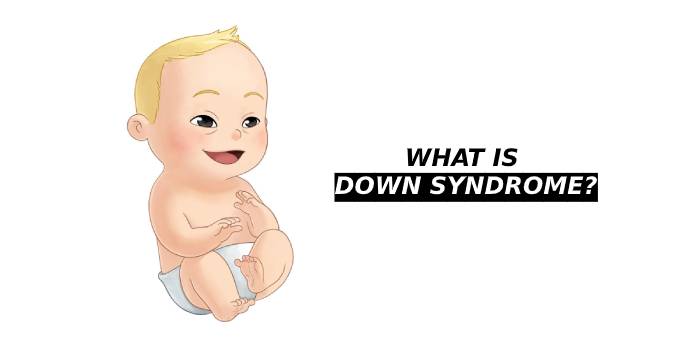What Is Down Syndrome?
Down syndrome is a condition where a person has more than one chromosome. The body’s small “packages”, or chromosomes, are small groups of genes called chromosomes.
These genes determine how the baby’s body develops and functions during pregnancy and after birth. A baby usually has 46 chromosomes. Down syndrome babies have an extra copy (chromosome 21) of one of these genes.
Trisomy is the medical term for an extra copy of one chromosome. It is also known as Trisomy 21. This extra copy can affect the way the baby’s brain and body develops, which can lead to mental and physical challenges. Despite the fact that Down syndrome people may look and act alike, everyone is unique. People with this condition have an IQ (a measure or intelligence) that is in the moderately-to-moderately high range. They also speak slower than other children.
Common Physical Characteristics of Down Cyndrome include:
- Flattened nose bridge and face, especially at the bridge
- Almond-shaped eyes that slant upward
- A shorter neck
- Small ears
- A tongue that sticks out of the mouth
- Tiny white spots (the colored part of the eye) on the iris
- Small feet and hands
- One line (palmar crease), across the palm of your hand.
- Sometimes, small pinky fingers curve towards the thumb
- Loose joints or poor muscle tone
- Children and adults are shorter in height
How are Babies Born with Down Syndrome?
The most common chromosomal disorder in America is still Down syndrome. About 6,000 children born in the United States each year have it. And it is found in approximately 1 in 700 children born in the United States each year.
What are The Types of Down Syndrome?
There are three types Down syndrome. Because of the similarities in physical characteristics and behavior, it is often difficult to tell which type is which without looking at the DNA.
- Trisomy21: Approximately 95% of Down syndrome patients have Trisomy21. Each cell has 3 copies of chromosome 21, instead of the 2 that is normally found in the normal 2 copies.
- Translocation Down Syndrome: This is when a part of or all of chromosome 21 are present but is attached to or “translocated” (attached or “translocated”) to another chromosome.
- Mosaic Down syndrome This condition affects approximately 2% of people with Down syndrome. Mozaic is a mixture or combination. Children with mosaic condition have three copies of chromosome 21 in their cells, while others have two copies. Children with mosaic Down syndrome might have similar features to other Down syndrome children. They may exhibit fewer symptoms due to the presence or a few cells that have a common number of chromosomes.
The causes and Risks
- People with Down syndrome can have different physical characteristics and developmental difficulties due to an extra chromosome 21. Although researchers know that Down syndrome is due to an extra chromosome 21, no one really knows why or what other factors may play a part.
- The mother’s age is one factor that can increase the chance of having a Down syndrome baby.
- Pregnancy After 35, is a big factor.
Diagnosis
Screening tests and diagnostic tests are the two main types of tests that can detect Down syndrome in pregnancy. A screening test will tell the woman and her doctor if her chances of developing it are lower or higher.
Although screening tests don’t provide an exact diagnosis, they can be safer for both the mother and her baby. Although diagnostic tests are able to detect Down syndrome in most cases, they can pose a risk for both the mother and baby. Screening or diagnostic tests can not predict the full impact of Down syndrome.
Screening Tests
These tests may include a combination blood test that measures the amount and type of substances in the mother’s body, as well as an ultrasound, which takes a picture of the baby. The fluid behind the baby’s neck is one of the first things that an ultrasound technician will examine. This could be a sign of a genetic problem. These screening tests can help to determine if the baby is at risk for Down syndrome. Screening tests may give abnormal results even if there are no problems with the baby. Sometimes the results of screening tests are normal but miss a problem.
Diagnostic Tests
A positive screening test is usually followed by a diagnostic test to confirm the diagnosis of Down syndrome. There are many types of diagnostic tests:
- Chorionic villus sampling (CVS), which examines material from placenta
- Amniocentesis–examines the amniotic fluid (the fluid from the sac surrounding the baby)
- Doctors use Percutaneous umbilical blood sampling, (PUBS), to test blood from the umbilical chord.
These are the tests doctors use to detect changes in the chromosomes which could indicate Down syndrome.
Other Health Problems
People with Down syndrome often have common facial features, and there are no major birth defects. Some people with may have one or more serious birth defects, or other medical issues.
- Hearing loss
- Obstructive sleep apnea is a condition in which the patient’s breathing temporarily stops during sleep.
- Infections of the ear
- Eye diseases
- Heart defects present at birth
Health care provider regularly monitor children with this problem.
Treatments
Down syndrome can be a lifelong condition. Children and babies with Down syndrome can often benefit from services early in their lives. Health care providers design these services to help children to reach their full potential. These services can include speech, occupational and physical therapy and are usually offered by early intervention programs in each state. Even though some specialists prefer to include many children with this condition in regular classes, some may need additional help or attention at school.
